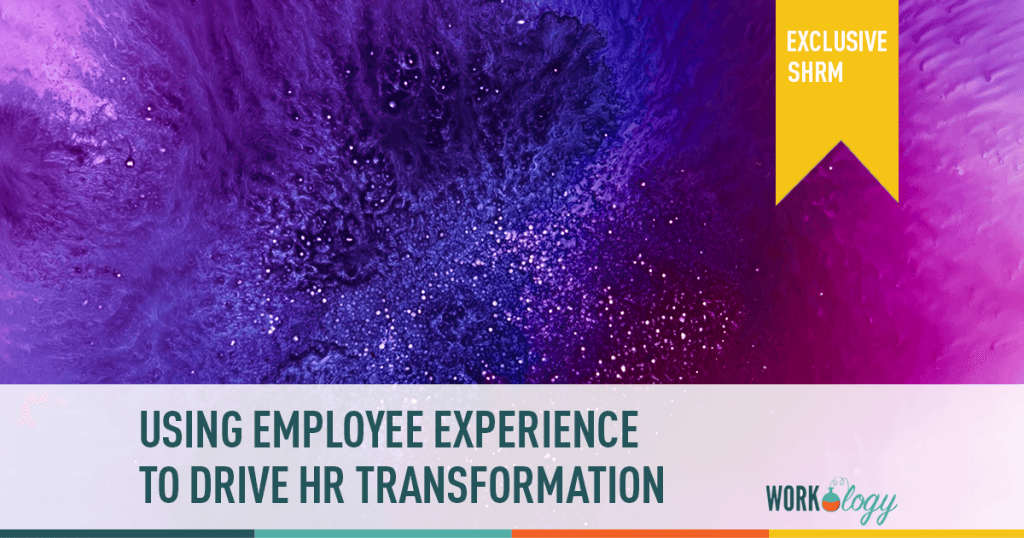There were so many amazing workshops and sessions during the June 2019 Annual SHRM conference it was difficult to choose which to attend, but I knew well ahead of time that HR transformation would be at the top of my list. I’ve covered employee experience and HR transformation as it relates to empathy and design thinking here before, most recently in a podcast interview on Driving Innovation in HR with Design Thinking with Dorothy Mankey, Employee Strategy Consultant for Coreisma Consulting.
With this in mind, I attended SHRM session HR Transformation Led by Employee Experience presented by Marcelo Godinho Ribeiro, Partner, EY and Oliver Kamakura, Partner, Ernst & Young. Using a case study on an HR Transformation project for a Brazilian company that challenged its HR function to evolve from service providers to experience designers. Using the case study, Ribeiro and Kamakura covered the journey that begins with organizational purpose and the employee value proposition (EVP), through company leadership’s role in identifying areas for improvement using data, to how to engage your workforce by promoting a human-centered culture and transformation through agile and design thinking.
Using Employee Experience to Drive HR Transformation
As a high-level outline for HR transformation, Ribeiro and Kamakura touched on four specific areas:
· The power of employee experience to the transformation journey.
· How HR should be a strategic player in leading transformation.
· How executive support is a necessity in ensuring the transformation is a success.
· Reinforce the importance of the human factor during transformation and change.
Empathy is key to understanding the power of employee experience to the transformation journey, and it’s a component of the design thinking process. Studies on organizational change show that leaders across the board agree: if you want to lead a successful transformation, communicating empathetically is critical. Applied empathy requires a self-aware perspective to gain a richer and deeper understanding of employee experience. It also helps you better understand your customers and clients and for your workforce, as applied empathy lets you relate to and understand your work colleagues, peers, and employees. This is extremely important in creating a workplace culture where people and individual ideas and contributions are valued and encouraged. Empathy is key in reinforcing the human factor during transformation and change.
I’ve been a proponent of HR as strategic partners that lead transformation (see part 1 and part 2 of my Strategic HR series). While HR has often been seen as an administrative function, it has evolved over time into a driving force for transformational change in the workplace. It is HR that will lead the charge to reinforce the “human” aspect of human resources, which is what really engages your workforce and elevates your employee experience.
And this brings us back to design thinking. It is human-centered, taking into account all the needs and concerns of the ultimate user. Design thinking provides a framework that is focused on the user experience by deeply understanding the customer or, in HR’s case, the candidate or employee. I love this case study that Marcelo and Oliver shared. It’s great to see empathy and design thinking process in action within the HR and employee engagement umbrella.
We instinctively develop patterns of thinking modeled on repetitive activities and commonly accessed knowledge. This can help us quickly apply the same actions and knowledge in similar or familiar situations, but they also have the potential to prevent us from quickly and easily accessing or developing new ways of seeing, understanding and solving problems. With design thinking, the primary intention is to improve products by analyzing and understanding how users interact with products and investigating the conditions in which they operate. It’s the difference between speculation and analysis.
Design thinking offers us a means of digging a bit deeper; it helps us to do the right kind of research and to prototype and test our products and services to uncover new ways of improving the product, service or design. Design thinking gives us data points via a creative process, and it’s commonly referred to as “outside of the box” thinking (as much as we’d like to drop that from our vernacular).
In the future – in order to remain competitive in today’s talent marketplace and relevant to our employees, HR teams will move from designing programs to designing experiences. This allows us to become more strategic and effect a shift to human-centric employee experience within our organizations.









3 Comments
One thought here that really resonates is the need for the mass customisation of employee experience, where every employee is a market of one. Put it another way, we are all very different, and great organisations are learning how to embrace diversity and personalise employee experience with – http://www.peoplehum.com/#bl
MIs EMERLY can i have web site of cola or i should forward to cv in order to forward the application for job
through u
Hi Jessica! This is a really well written article on the employee experience that drives HR transformation…Just wanted to get your opinion on something – I was just reading this article about digital version of HR
What’s your thoughts?
Comments are closed.